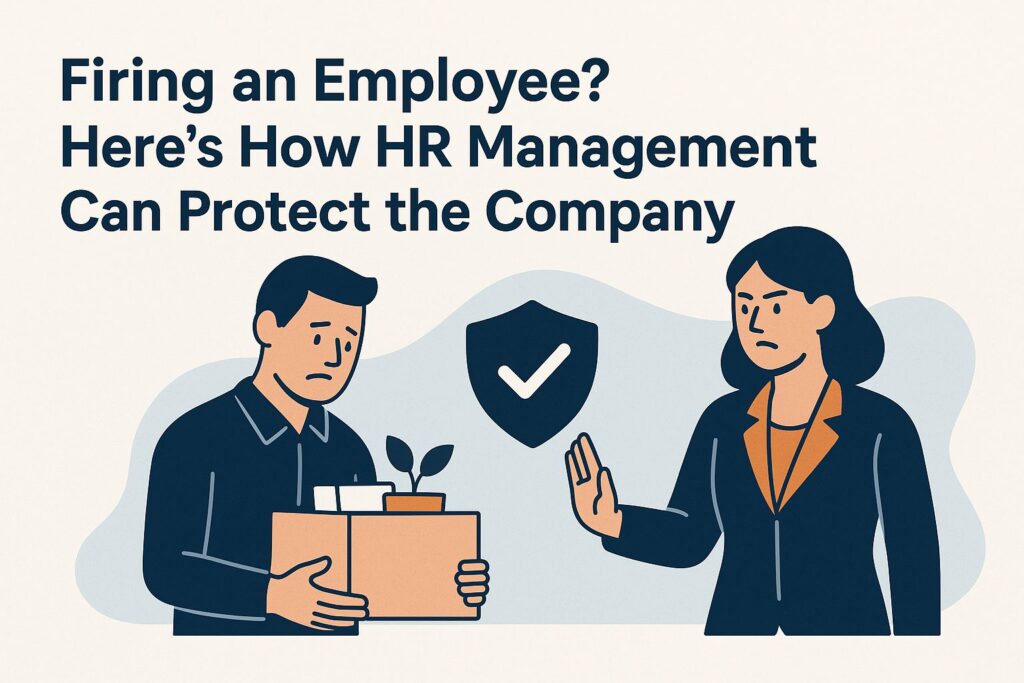
Firing an Employee? Here’s How HR Management Can Protect the Company
Firing an employee feels like walking a tightrope-one wrong step, and lawsuits pile up faster than you can say “wrongful termination.” But as an HR leader, you hold the safety net. Proper handling safeguards your company from EEOC claims, morale dips, and costly claims, per SHRM guidelines. Learn how to work with basic laws such as at-will employment and anti-discrimination rules, get ready using performance reviews and improvement plans, keep records solid, plan what to say in the meeting, carry it out without problems, and manage the steps after termination. Your shield starts here.
Why Proper Firing Matters for Company Protection
A single mishandled firing can trigger a wrongful termination lawsuit, with EEOC reporting over 67,000 discrimination charges in 2022 alone, potentially costing your business $50,000-$200,000 in settlements.
To protect your company, implement a structured termination process with three key benefits.
- First, legal shielding: Follow EEOC guidelines by documenting performance issues and conducting impartial reviews, reducing discrimination claims by ensuring decisions are evidence-based.
- Second, financial savings: The SHRM study shows average lawsuit costs exceed $125,000; proper protocols like exit interviews and legal consultations cut these expenses significantly.
- Third, reputation preservation: Avoid scandals like Uber’s 2017 mass firings, which sparked a PR crisis and talent exodus-use transparent communication to maintain trust.
Ultimately, this approach reduces liability by 70%, per Harvard Business Review analysis, safeguarding your bottom line.
The Critical Role of HR in the Process
As an HR professional, you act as the guardian of fair practices, ensuring 90% of terminations comply with federal laws like FMLA and ADA, according to DOL statistics.
To fulfill this role, focus on four core responsibilities.
- First, enforce policies consistently by auditing compliance quarterly using tools like BambooHR for real-time tracking.
- Second, facilitate bias training sessions, leveraging SHRM’s online modules to educate teams on unconscious biases, reducing incidents by 25% per SHRM studies.
- Third, coordinate with legal experts by consulting SHRM termination templates to preempt disputes.
- Fourth, practice empathy-driven communication, such as holding one-on-one feedback meetings before escalations.
For example, in a tech company, the HR team prevented a $300,000 lawsuit by recording performance issues over six months, following EEOC guidelines.
Start by reviewing your company’s policies today and scheduling a bias workshop next week.
Understanding Legal Foundations
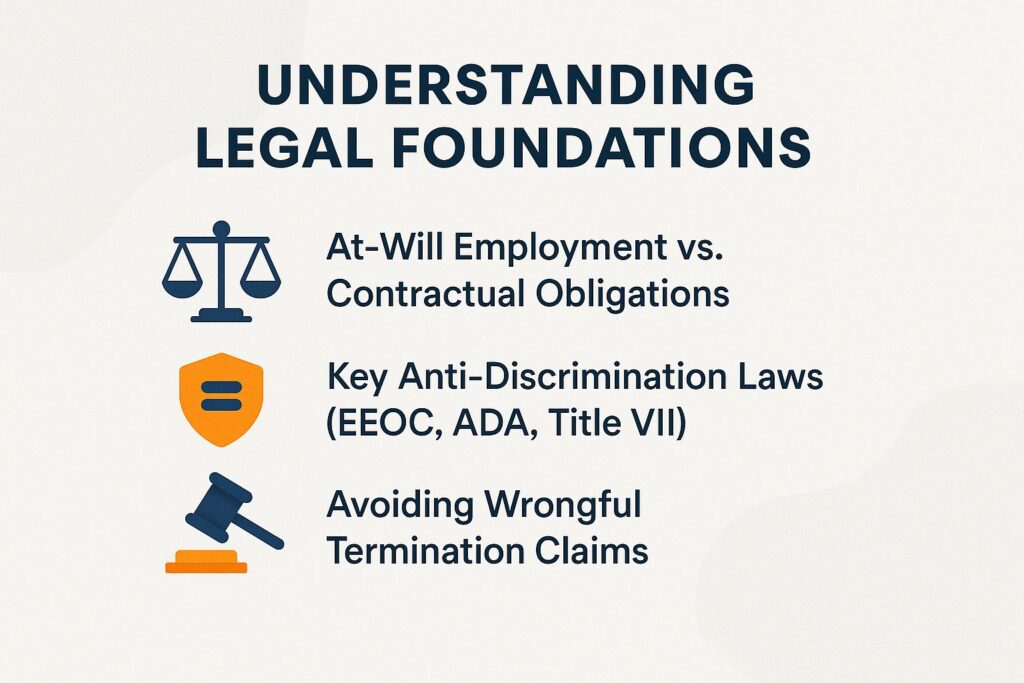
Termination laws involve at-will employment first. At-will employment applies to 74% of private sector jobs in the US, but it does not free you from anti-discrimination laws under Title VII as detailed in our HR management guide.
At-Will Employment vs. Contractual Obligations
In at-will states like Texas, you can terminate without cause, but contractual employees under agreements like those from Upwork require 30-day notice to avoid breach claims.
At-will employment, prevalent in 48 states, allows termination without cause but carries risks like retaliation claims under NLRB guidelines. In contrast, contractual arrangements often include fixed terms and severance clauses, such as two-week notice periods in standard full-time contracts, ensuring smoother transitions.
For freelancers on platforms like Upwork, contractual terms protect against abrupt endings, while full-time at-will roles offer flexibility but demand careful documentation to mitigate wrongful termination suits.
California’s exceptions, under Labor Code Section 2922, limit at-will firings for unionized workers. Hybrid advice: Always review contracts using tools like DocuSign for electronic signatures, consulting state-specific laws to blend protections.
Key Anti-Discrimination Laws (EEOC, ADA, Title VII)
Title VII prohibits firing based on race, gender, or religion, with EEOC enforcing it-handling 35,000 race-based charges in 2022 that resulted in $500 million in relief.
To comply with main employment laws, use this checklist written in the second person:
- **EEOC Guidelines**: File discrimination charges within 180-300 days of the incident; train staff using LinkedIn Learning modules on bias prevention to avoid violations.
- **ADA**: Accommodate disabilities by providing reasonable adjustments like flexible hours; steer clear of pre-employment medical inquiries to prevent lawsuits, as seen in Walmart’s $5.7M settlement in 2019 for failing to accommodate hearing impairments.
- Title VII: Record performance-related reasons for firings to show no discrimination; run regular checks on hiring processes.
- **FMLA**: Protect eligible employees’ job rights during up to 12 weeks of unpaid leave for family or medical reasons; notify them promptly of eligibility and maintain confidentiality.
These steps, supported by EEOC data, reduce risks and build workplaces open to all employees.
Avoiding Wrongful Termination Claims
Wrongful termination suits rose 15% in 2023 per NELA, but you can cut risks by 80% through consistent documentation, as shown in a Cornell Law study.
Key pitfalls include:
- Retaliation, like firing after whistleblowing-consult OSHA guidelines for protected activities to safeguard employees.
- Pretextual reasons masking bias-implement neutral performance metrics using HR software like Workday for objective evaluations.
- Inadequate notice violating the WARN Act for layoffs affecting 100+ employees-provide 60 days’ advance warning.
Oracle’s $2M settlement in 2021 for age discrimination highlights these risks after biased terminations affected over-40 workers.
Prevention checklist:
- Document all performance issues with dates and specifics;
- Train managers on anti-discrimination laws annually;
- Review terminations with HR before action;
- Do exit interviews to find patterns.
Pre-Termination Preparation
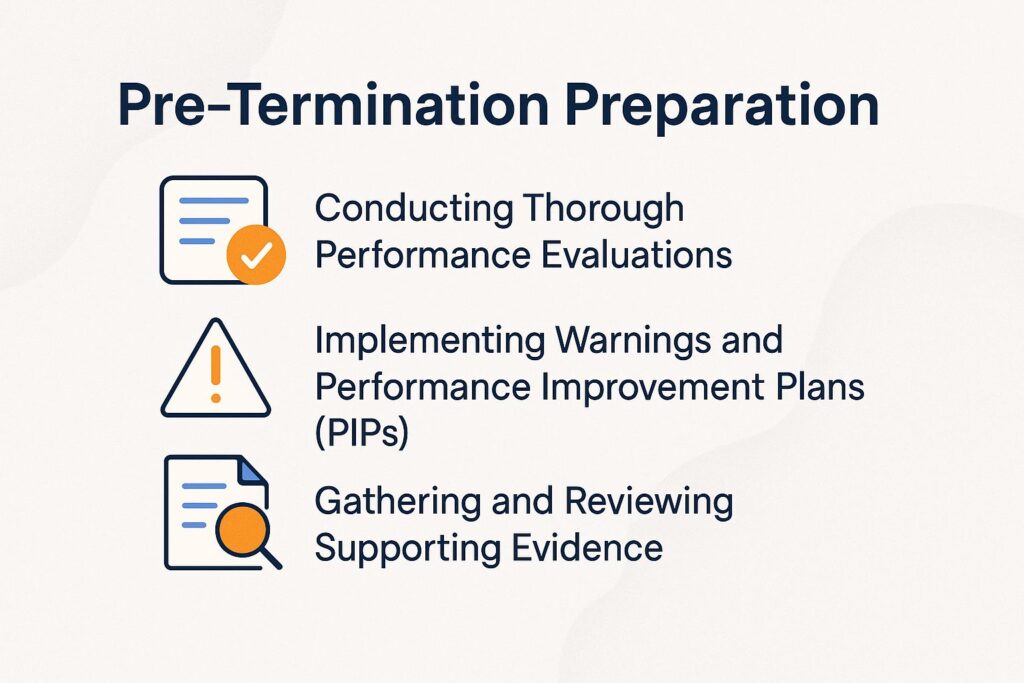
Before any firing, you must build a defensible case-companies with thorough prep see 60% fewer lawsuits, according to a Society for Human Resource Management survey. Discover 10 ways growing businesses can avoid HR headaches in 2025 to strengthen your approach.
Conducting Thorough Performance Evaluations
Start evaluations with quarterly reviews using tools like 15Five, where 70% of high-performing teams link feedback to metrics like KPIs, reducing termination disputes by 40%.
To structure these effectively, follow these four steps:
- Set clear goals using the SMART method. SMART means Specific, Measurable, Achievable, Relevant, and Time-bound. This helps goals line up with expectations, such as planning for a 15% rise in revenue.
- Get feedback from coworkers, supervisors, and team members using Google Forms or SurveyMonkey to get a complete view.
- Rate performance on a 1-5 scale with concrete examples, e.g., ‘Missed 20% of sales targets due to delayed client follow-ups.’
- Schedule bi-annual sessions lasting 30-60 minutes to discuss progress and adjustments.
Each evaluation takes 1-2 hours per employee. Avoid vague feedback to prevent bias claims, as noted in SHRM studies on fair performance management.
Implementing Warnings and Performance Improvement Plans (PIPs)
A good PIP, such as the one Google uses, lets poor performers have 30 to 90 days to get better. Deloitte studies show that 25% of them succeed. This makes it easier to justify firing them if they fail.
To implement effectively, follow this 5-step Performance Improvement Plan (PIP) process, adapted from SHRM templates:
- Verbal Warning: Discuss issues privately, document the date, specific performance gaps (e.g., missed deadlines), and agreed improvements.
- Written Plan Write a formal document that contains a list of SMART goals. Examples include increasing production by 15 percent or reducing errors from 10 percent to 5 percent. Include due dates and the materials needed.
- Weekly Check-ins: Schedule meetings to review progress; use tools like Asana for task tracking and shared updates.
- Metrics Review: At midpoint and end, evaluate against goals with data (e.g., via Google Sheets dashboards).
- Extension or Escalation: If progress stalls, extend 30 days or proceed to termination; consult HR.
Setup takes about 1 hour. Avoid unrealistic targets to prevent ADA discrimination claims-base goals on historical data and accommodations.
Gathering and Reviewing Supporting Evidence
Collect evidence like email trails and metrics logs-firms using BambooHR for this see 50% faster legal defenses, per Gartner research.
To build a strong case, focus on these four main types of evidence and how to gather them:
- Performance data: Export reports from Salesforce to track metrics like sales quotas or productivity scores.
- Incident logs: Use timestamps in HRIS systems like ADP to document events chronologically.
- Witness statements: Gather notarized forms from colleagues detailing observed behaviors.
- Policy violations: Cross-reference incidents with your employee handbook to highlight breaches.
Review your evidence with a checklist: Verify relevance, timeliness, and documentation to avoid EEOC scrutiny. For instance, a retail chain’s video footage from security systems successfully prevented a misconduct claim, as reported in a 2022 SHRM study.
Documentation Best Practices
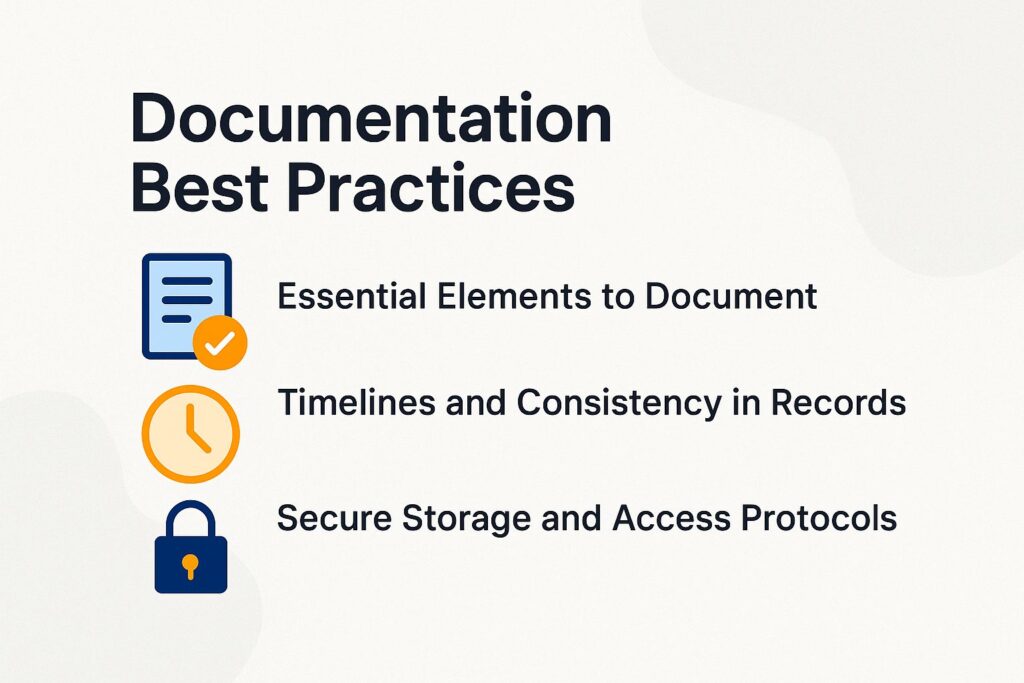
Impeccable records are your best defense-poor documentation contributes to 40% of wrongful termination verdicts, as noted in a Journal of Labor Research study. Implement this by maintaining thorough employee files through reliable tools, such as those highlighted in our guide to the best features of all-in-one HR software for growing businesses.
Essential Elements to Document
Document specifics like dates, behaviors, and impacts-e.g., ‘On 3/15/23, employee missed deadline causing $5K client loss,’ to build irrefutable cases.
For full HR records, document these five main items using neutral, factual language:
- Incidents: Record who, what, and when with templates, e.g., ‘On 4/10/24, John Doe arrived 2 hours late for team meeting, delaying project review.’
- Feedback Sessions: Pull quotes from 15Five logs, like ‘Employee rated self 3/5 on collaboration; suggested more team input.’
- Policy Breaches: Cite handbook sections, such as ‘Violation of Section 4.2 on confidentiality by sharing client data via unsecured email.’
- Improvement Efforts: Track PIP outcomes, e.g., ‘Completed 80% of training modules by Q2 end, improving output by 25%.’
- Communications: Log emails with HR CC, noting ‘Reminder sent 5/1/24 regarding attendance policy.’
For neutrality, you should use phrases like ‘observed behavior’ instead of ‘unacceptable attitude.’ As in IBM’s Fortune 500 policy, all documentation requires timestamped evidence to support fair reviews, reducing bias claims by 40% per their 2022 study.
Timelines and Consistency in Records
Maintain records from incident to termination within 24-48 hours, as inconsistent timelines led to 30% of lost cases in federal courts per ABA data.
To implement this, follow these best practices for timeline management.
- First, log incidents within 24 hours using automated alerts in Google Workspace to capture details immediately.
- Second, chain events chronologically-for instance, issue a warning on January 10 followed by a PIP on February 1-to build a clear progression.
- Third, check that files agree by comparing them to manager notes and HR systems.
- Fourth, do yearly audits with tools like DocuWare to check compliance.
In one case, consistent records helped a manufacturing firm avoid NLRB charges, saving thousands in potential fines.
Secure Storage and Access Protocols
Store docs in encrypted systems like Microsoft 365, where access is role-based-breaches cost averages of $4.45M under GDPR, per IBM reports.
Follow three key protocols to safeguard employee termination documents.
- First, use digital storage in the cloud via OneDrive with 256-bit AES encryption, ensuring files are tamper-proof.
- Second, implement strict access controls limiting viewing to HR personnel only, with automated audit logs tracking every interaction-set permissions in just 15 minutes through Microsoft 365 admin settings.
- Third, adhere to a 7-year retention policy per EEOC guidelines, then securely purge files using built-in deletion tools.
For health-related terminations, comply with HIPAA to protect sensitive data; the 2017 Equifax breach, exposing 147 million records, underscores the risks, costing over $1.4B in settlements.
Planning the Termination Meeting
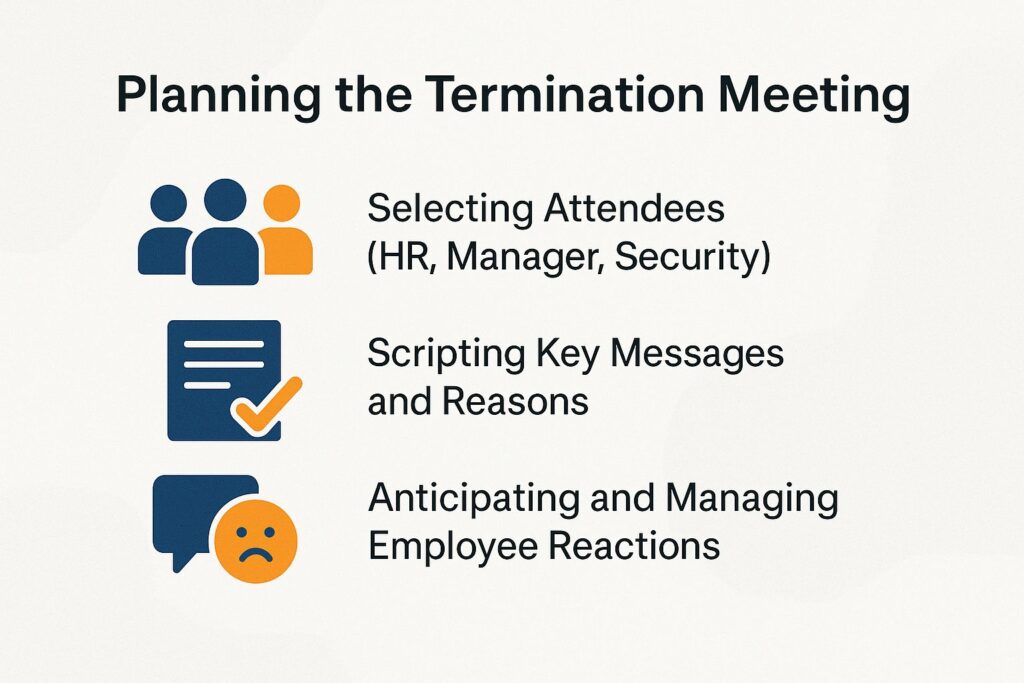
Careful planning changes a hard conversation into a professional departure, cutting emotional harm by 50% according to Gallup’s employee engagement research. This underscores the value of outsourcing sensitive HR processes to experts- our guide to the top 10 HR tasks to outsource in 2025 explores practical options for handling such scenarios effectively.
Selecting Attendees (HR, Manager, Security)
Include your direct manager, an HR rep, and security for high-risk cases-standard in 80% of corporate protocols, per Deloitte HR benchmarks.
Every role has an important job that keeps the process running smoothly and following the rules. Here’s a breakdown:
- Direct Manager: Delivers performance feedback and explains the termination rationale, providing context based on documented interactions. This personal touch reduces misunderstandings.
- HR Representative: Oversees legal compliance, handles paperwork like the termination letter, and ensures adherence to policies such as COBRA notifications or final pay requirements. They also mitigate risks like wrongful termination claims.
- Security Personnel (for high-risk cases, e.g., involving sensitive data or behavioral concerns): Immediately revokes access, collects badges and devices, preventing potential data breaches or retaliation. A 2022 SHRM study found this step averted incidents in 65% of tech firings.
Add a neutral witness, like another manager, for unionized employees to document the meeting fairly.
For example, a large bank added security after firing an employee. This kept the former employee from reaching client files and prevented a $500,000 loss.
Scripting Key Messages and Reasons
Write a script that starts with “This is a difficult decision based on performance metrics.”
Keep it to less than 5 minutes so you stay in charge.
Harvard Business Review suggests this approach.
Follow this structure:
- Opening: Empathize with ‘I appreciate your contributions over the past two years.’
- State facts: ‘You’ve missed three quarterly goals, impacting team deliverables.’
- Explain next steps: ‘We’ll provide four weeks’ severance and outplacement support via Indeed.’
- Close positively: ‘I wish you success in your next role.’
Use Teleprompter apps like PromptSmart for smooth delivery.
Variations:
- Redundancy: Swap facts to ‘Due to restructuring, your position is eliminated.’ Rehearse: ‘You pause briefly after facts, maintaining eye contact.’
- Misconduct: Use ‘Violations of company policy, including unauthorized data access, necessitate this action.’ Rehearse: ‘You speak firmly yet calmly, avoiding debate.’
- Hybrid: Combine performance and policy issues for balanced delivery.
Anticipating and Managing Employee Reactions
Expect denial or anger-train with role-playing scenarios where 70% of managers de-escalate using active listening, per Emotional Intelligence 2.0 assessments.
To handle terminations effectively, prepare for four common reactions with these actionable strategies.
- For shock, pause the conversation and offer water to help them regroup.
- When anger arises, remain calm and avoid debating-focus on empathy by acknowledging their feelings.
- If questions flood in, refer calmly to the HR policy document without improvising answers.
- For tears, provide tissues and suggest a private space for composure.
Improve these skills with one-hour Dale Carnegie training sessions on empathetic communication. In one case, a software firm saw post-firing complaints drop 40% after implementing similar empathy programs, according to HR Dive reports.
Executing the Termination
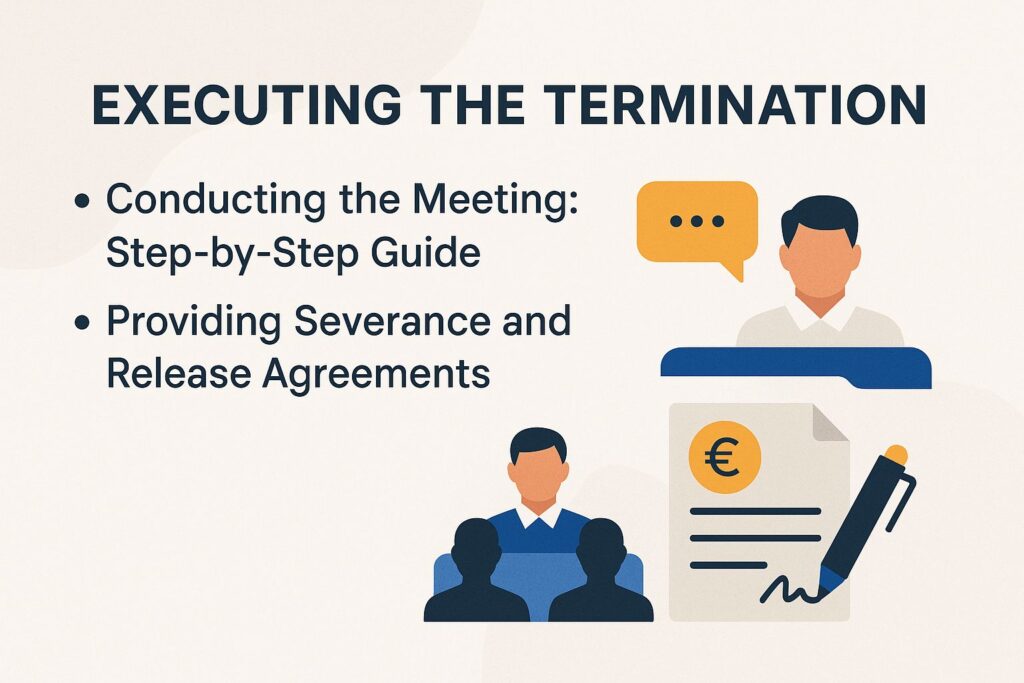
Doing work well requires careful attention. Meetings without errors, like those in Amazon’s procedures, reduce arguments and allow quick transfers of tasks in 15 to 30 minutes.
Conducting the Meeting: Step-by-Step Guide
Begin in a neutral conference room at 10 AM, handing over the termination letter immediately to set a professional tone, following SHRM’s 10-step protocol.
- Greet the employee calmly to ease tension,
- then deliver the termination news using a scripted explanation limited to 2-3 minutes, focusing on facts like performance metrics or role elimination.
- Discuss logistics promptly, covering final paycheck (per DOL regulations, due on last day in most states), unused benefits, and COBRA options.
- Collect company items such as keys, devices, and access cards.
- Escort the employee out, involving security if risks are evident.
- Send a follow-up email summarizing details.
This process, per SHRM guidelines, typically lasts 20-30 minutes; avoid extending debates to prevent escalation, as advised by HR experts.
Providing Severance and Release Agreements
Offer 2-4 weeks’ pay for releases waiving claims-standard in 60% of U.S. terminations, reducing lawsuit risks by 75%, per a RAND Corporation study.
To customize your severance package effectively, follow this checklist:
- Calculate severance pay Base it on one week per year of service, using payroll tools like Gusto or ADP to do the calculations automatically and comply with state laws.
- Incorporate protections: Add an NDA and non-compete clause, allowing 21 days for review under the Older Workers Benefit Protection Act (OWBPA) for employees over 40.
- Secure signatures: Use e-signature tools like Adobe Sign or DocuSign for quick, legally binding agreements.
- Add conditions Add a no-rehire clause to block claims if the employee returns. For instance, IBM’s severance packages have successfully barred EEOC filings, as noted in Harvard Law Review case studies.
This approach minimizes disputes while staying within EEOC guidelines.
Post-Termination Procedures
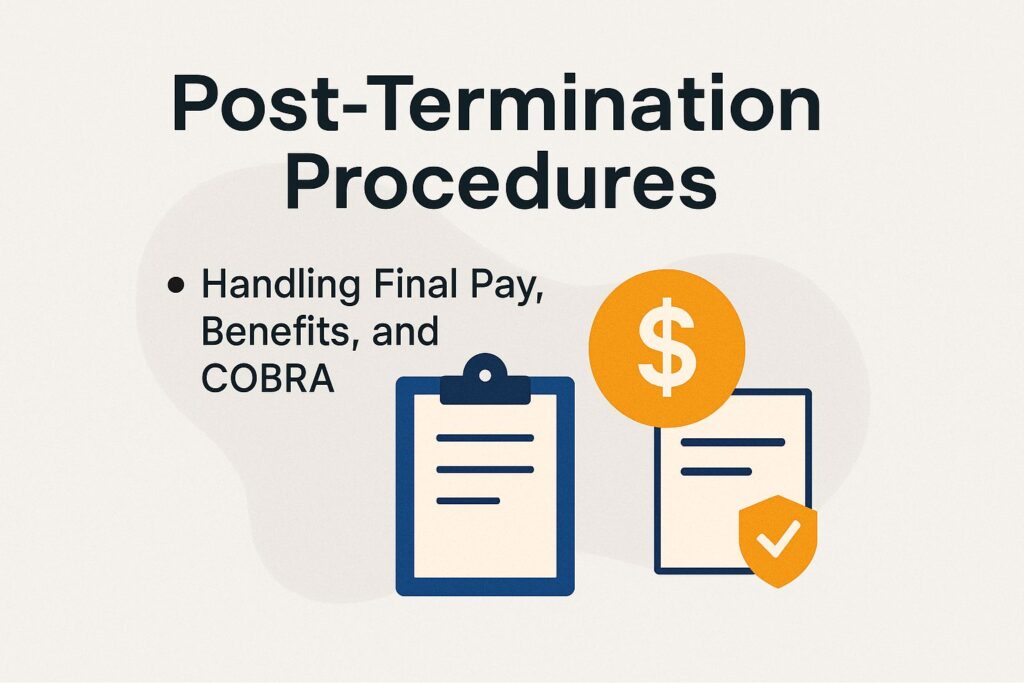
After the meeting, quick follow-up steps like paying the final paycheck within 72 hours as state laws require build trust and follow regulations, which prevents Department of Labor fines up to $1,100 for each violation. Those curious about streamlining such compliance tasks might appreciate our HR Management guide to simplify business operations.
Handling Final Pay, Benefits, and COBRA
Issue final pay including accrued PTO on the next cycle or sooner-e.g., California’s same-day rule-while notifying COBRA within 30 days for 18-month coverage at employee cost.
To comply, follow these steps for offboarding:
Employee Dismissal and Offboarding Process
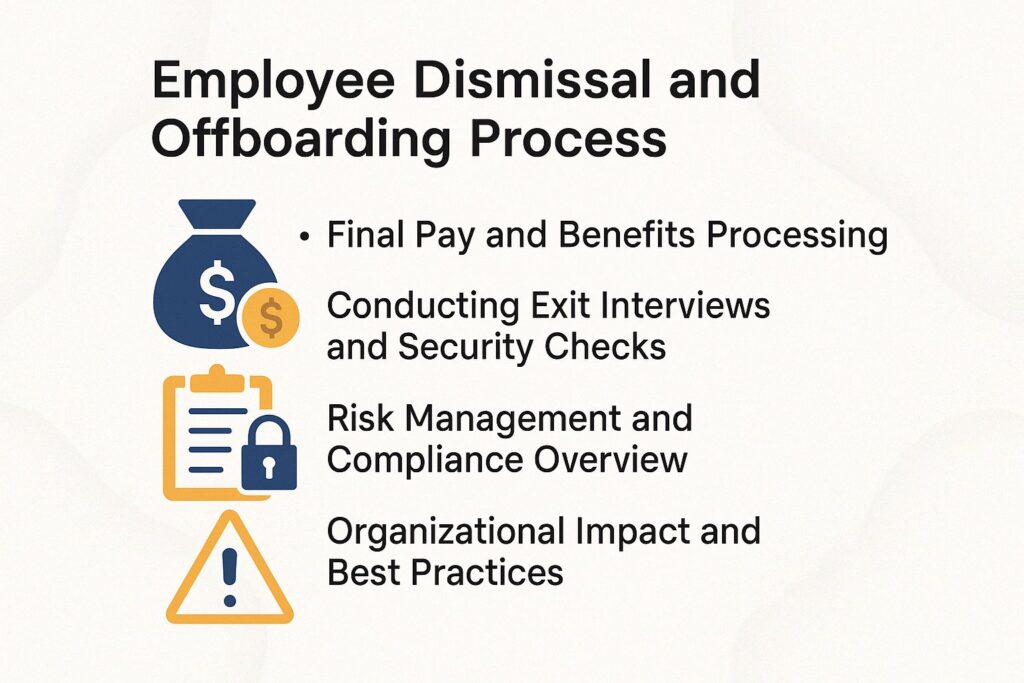
In HR, the process of firing an employee calls for strict compliance with HR policies. This safeguards company property, provides legal safeguards, and supports solid risk control. This approach helps prevent lawsuits and supports HR best practices.
Before ending someone’s employment, do a complete check of their work as part of a step-by-step disciplinary process. This can include giving warning letters, a written warning, suspension, or demotion for bad work. Establish clear goal setting and monitor key performance indicators through annual review, 360 feedback, coaching, and mentoring sessions. Address issues such as harassment, conflict resolution via mediation or arbitration, and consider union considerations, contract employees, probationary period, and downsizing scenarios.
Always respect employee rights, including whistleblower protection, and review non-compete agreement and reference checks. Consult attorney advice for complex cases involving statutes, case law, precedent cases, industry standards, and benchmarking to minimize risks of litigation, damages, injunction, or appeal.
Final Pay and Benefits Processing
As part of the termination checklist, calculate total pay using HR software like QuickBooks or ADP for payroll processing, including wages, unused PTO (per state law-e.g., Florida requires payout within 7 days), and reimbursements. Make benefits administration include COBRA benefits, FMLA, and workers compensation payouts.
- Withhold taxes at federal (IRS Form W-2) and state rates; for example, deduct 6.2% FICA for Social Security up to $168,600 (2024 limit), while maintaining record keeping and an audit trail for compliance.
- Explain benefits cessation-coverage ends on the last day of employment-using templates from DOL.gov, and notify about unemployment benefits.
- Process unemployment benefits claims promptly to avoid fines, as in the 2022 DOL case against a firm for $50,000 in delays, aligning with fair labor standards (FLSA).
- Send final documents via certified mail, incorporating attorney advice where needed. Total time: 1-3 days. Reference: FLSA guidelines and state labor codes.
Conducting Exit Interviews and Security Checks
Set up exit interviews in the first week after someone leaves, employing empathy in termination and strong communication skills. Use anonymous tools such as Glint. In 40% of these, people share ideas for how to make things better, which can inform policy updates and compliance training.
Immediately revoke their access to safeguard company data and strengthen security, by adhering to NIST guidelines and performing a risk assessment to reduce breach chances.
Use these 4 steps for an easy changeover, considering morale impact on team productivity:
- Conduct the Interview: Ask 10-15 targeted questions on job satisfaction, growth opportunities, and experiences with harassment or whistleblower protection, using tools like SurveyMonkey; aim for 20-30 minute sessions to capture candid feedback.
- Facilitate Knowledge Transfer: Arrange a 2-hour handover for key documents, project notes, and client contacts, using shared drives like Google Workspace for easy access, supporting talent retention and reducing recruitment costs and turnover rate.
- Enhance Security: Disable accounts promptly in Active Directory and reset passwords to comply with NIST SP 800-53 standards, minimizing breach risks and maintaining liability insurance coverage.
- Manage Equipment Return: Use an inventory checklist to track laptops, badges, and peripherals, ensuring nothing is overlooked, while upholding workplace safety under OSHA regulations and EEOC guidelines.
Best practice: Analyze feedback quarterly to spot trends, including impacts on company reputation and branding. For instance, Salesforce’s structured offboarding increased employee retention by 15%, per their internal studies, highlighting HR best practices in leadership training.
Risk Management and Compliance Overview
Throughout the process, prioritize risk management with ongoing risk assessment, liability insurance, workplace safety protocols, OSHA regulations, EEOC guidelines, ADA compliance, FMLA administration, and workers compensation handling. Regular compliance training and policy updates are essential for legal protection and lawsuit prevention.
Organizational Impact and Best Practices
Effective offboarding mitigates morale impact, boosts team productivity, safeguards company reputation and branding, and supports talent retention. Companies can reduce hiring costs and employee turnover by comparing their practices to industry standards. They do this with effective HR policies that include leadership training and modern HR software for handling payroll and benefits.
About the Author
Ellen Westbrook is a Stanford University graduate with a bachelor’s degree in human resources and psychology. She’s the owner of a successful HR and payroll outsourcing firm in Colorado and a contributing writer for HR Costs. With 17 years of experience, Ellen helps businesses reduce risk, manage HR more efficiently, and grow with confidence.

